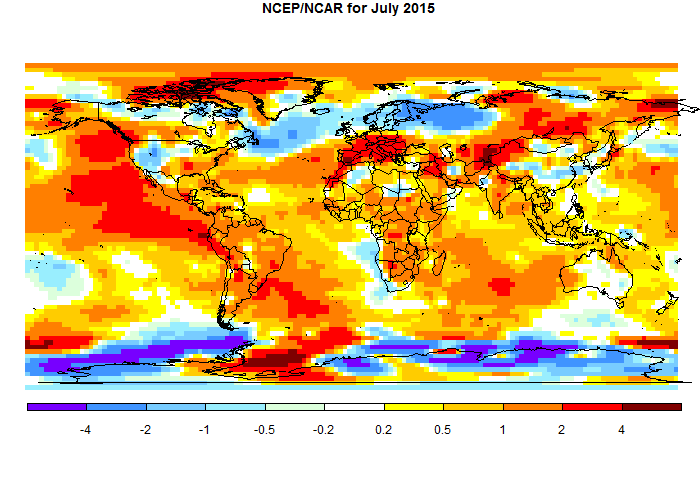The native anomaly period I've chosen is 1994-2013, which is a period where the reanalysis seems most reliable. I now, in the left column of the table, and below the month averages, show averages relative to GISS and NOAA bases. This uses those indices to fill the gaps (details here); it helps because it allows for the relative differences between months in one period vs another. Here are those tables:
1951-80 (GISS) base
| 1901-2000 (NOAA) base
|
The NCEP index has been generally under-predicting the surface data recently. I analysed its performance in earlier years here, and it tracked surface measures well. Is something different now?
I think the explanation is somewhat similar to the effect noted by the recent paper of Cowtan et al on GCMs and surface indices. Like GCMs, reanalyses return the air temperature of a near surface layer. I use sig995, which is basically 0.995 atmospheric, or an altitude of about 40 m. Surface indices use SST over ocean. This is a proxy for the air temperature, which they would like to use but have sparse measurements. It won't be perfect.
Recently, warm temperatures have been driven by rising SST. I did a detailed breakdown here to show this, but it has been the general trend for the last year or more. This year, Feb/Mar warmth was especially in Asia (land), but that faded and since has been dominated by SST. I think the air-based reanalysis may be lagging, and surface measures could be higher for a while.
As said, NCEP July was fairly close to April, so those are a reasonable guess for July - ie GISS 0.74°C, NOAA 0.78°C. But I wouldn't be surprised to see them a little higher.
Update. You can see the map for July anomalies as a globe here. Here is a map in the GISS style (and to 1951-1980 base) I use for the surface report. A lot of warmth in the E Pacific and Mediterranean region. Cool in N Europe and W Russia. Generally moderate in N America, but warm in the Arctic islands.













The AMOC is slowing down!
ReplyDeleteThat's expected isn't it?
Deletehttp://static.trunity.net/files/172601_172700/172603/amo_timeseries_1856-present-1.jpg
Yes, people have been talking about the AMOC slowing down and about the AMO being on the verge of a negative phase. The AMOC I buy, but I think the AMO has no choice other than to trend up.
DeleteThe AMO index?
DeleteI'd say the odds are very good that we'll see a decline in this over the next 20 to 25 years.
My guess for Giss July is down by 0.02 C from June, quite high, but a mixed balanced estimate based on ERSST up 0.04 and NCEP land down 0.15 C
ReplyDeleteOlof,
DeleteI've posted the TempLS result - a drop of 0.05. The breakdown is much as you suggest. I think your idea of a smaller drop in Giss is quite possible.